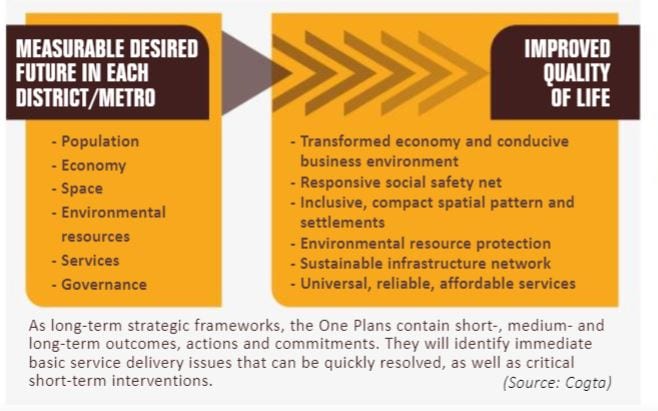When infrastructure plans don’t achieve their objectives, there’s a breakdown in trust between government, business and civil society. The District Development Model (DDM) of the Department of Cooperative Governance and Traditional Affairs (Cogta) sets out to address this, with the Development Bank of Southern Africa appointed as an implementing partner. But can government’s DDM deliver?
Encouraging open debate and inclusive viewpoints is the foundation for excellence in any society or nation. For South Africa’s construction sector, this is especially important given its negative GDP performance in recent years, which has had a corresponding knock-on effect in terms of shrinking employment. Government’s response to Covid-19 is an infrastructure-led economy, and South Africa’s world-class built environment sector is more than ready. But is government? On 27 January 2021, Cogta and the Development Bank of Southern Africa (DBSA) cohosted a webinar entitled ‘What is the government’s District Development Model and is it achievable?’ Government has appointed the DBSA as an implementing partner for the roll-out of the DDM. The webinar panel responses are published in this edition in an article entitled ‘Industry engagement on DDM implementation’. This article is the flip side of the coin, where we report on what the delegates thought within the real world of construction and service delivery. After all, this is not the first government attempt at a transformational infrastructure model.Past examples include Project Consolidate in 2005, the 2009 Local Government Turnaround Strategy, and Back to Basics in 2014. These have all run in parallel with overarching initiatives such as the National Development Plan, the Spatial Development Initiative, and the National Spatial Development Perspective. The two industry experts on the webinar panel were Dr Tracy Ledger, senior researcher, Public Affairs Research Institute; and Professor Louis Scheepers from the School of Government at the University of the Western Cape. Common responses stressed the need for clarity on the when, where and how?Positive poll survey
While there’s a great deal of frustration from industry, the upside is that the built environment remains cautiously optimistic; however, many feel their hands are tied by public decision-makers with limited or no proven field experience in successfully budgeting and implementing infrastructure programmes. This cautious optimism is reflected in the webinar poll survey, where 69% answered ‘Yes’ to the question, ‘Does South Africa have real prospects in achieving the vision of the DDM?’ Some 73% said the DDM was achievable; however, only 41% said ‘Yes’ to the question, ‘Do we have evidence demonstrating the success of localising and spatialising in the context of local government initiatives?’ The last response shows that there’s definite misalignment. But that’s the rationale for this debate in the first place, and the DDM’s introduction: nothing meaningful can be achieved if the private and public sector are not equal stakeholder partners.What the delegates said
Any built environment professional – public or private – in the 45-year-plus band will have invaluable input since they comprise graduates with 20 or more years’ applied experience post 1994. They also comprise the essential mentorship group that will transition the next generation to professional registration. Mature delegates dominated, which makes their opinions count. Most delegates said they’d experienced a “lack of a development logic” and some questioned whether previous models hadn’t ended up compounding the situation. Examples cited included the over-regulation of local government with complex legislation that few were qualified to understand or implement. For some, this has led to a “strangulation of local government effectiveness”. Others questioned the ‘bigger is better model’, particularly when it comes to the demarcation of municipal boundaries. An overriding question was, ‘How do we get the right people inplace?’ This is an obvious one, given the evidence presented by the Auditor-General’s reports on underperforming municipalities over the past decade.
Joint planning
Breaking down silos within the three spheres of government is a key policy shift. The emphasis is now on joint planning and execution, as defined by the DDM’s One Plan approach. ‘Will this joint planning philosophy work in practice?’ asked delegates, citing the previous infrastructure development framework models.Added to this were the questions: ‘How do we avoid repeating past mistakes?’ and, ‘Can we stick to the DDM plan?’
Panel viewpoints on delegate questions
Many delegates felt the quantum leap could only work if there’s a radical culture change. The questions posed were: ‘What cultural and behavioural changes are required to migrate into the new way of doing things?’ and, ‘Do we have to wait for another set of changes in regulations before DDM implementation?’ The response from Cogta is that government’s DDM provides that quantum shift opportunity to improve the overall ability of the state. This includes the greater adoption of technology in areas like geospatial data management and analysis. Cogta says the DDM is different because it’s instituted in terms of the Constitution and the Intergovernmental Relations (IGR) Framework Act (No. 13 of 2005). In terms of the IGR, the Minister of Cogta has the power to regulate the alignment or regulation of plans across the three spheres of government; however, the DDM is not on standby pending regulation changes. Cogta emphasises that any change in regulation will run in parallel with the DDM roll-out and be refined accordingly. Delegates and panelists agreed that we’re in a race against time to consolidate, recover and rebound from the socio-economic crisis exacerbated by Covid-19.How will the DDM break the past negative cycle of underperformance?
Cogta says that the DDM should not be viewed as another programme targeted at local government. In response, delegates asked if the joint planning approach was an effective means on its own of addressing implementation capability. Invited to respond, Dr Ledger says the short answer is no. Dr Ledger cites studies in the USA where studies have shown that policies and plans really have a limited impact on what gets done or doesn’t. The crucial deciding factor is the functionality of the state and not the plan itself. The importance of organisational cultures is a major influencing factor in ultimate success or failure. Historically, Dr Ledger says South Africa has focused too much on the plan and only started to look at implementation capabilities when things begin unravelling. Establishing open trust and communication is vital in restoring dysfunctional municipalities and depends on a participative, problem-solving culture. A cooperative relationship.The fiscal reality
Beyond the needed behavioural changes, the practical reality is that the DDM needs fiscal support to work. Part of this will come via central government and financial institutions, with the balance either directly or indirectly (e.g. via municipal rates and taxes) from regional private sector investors. However, the delegates said the industry needed more assurance that greater steps would be taken to eradicate maladministration, as well as wasteful and fruitless expenditure. Placing competent financial management at local government level is an essentialstarting point. Adding his thoughts on the ‘Will it work this time?’ debate, Professor Scheepers said government’s DDM presents exciting opportunities. He pointed out that where local government has failed in the past, this was indicative of the state. In explaining what excites him about the DDM, he stated, “We now have a chance to look at government performance holistically.”
Conclusions
In the end, it’s all about a meeting of the minds in achieving common goals. Delegates and panelists agreed that re-professionalising the public service is an obvious priority. Government and industry also need to come together to create business plans for municipalities, particularly poorer ones, to unlock their economic potential. With the right people, policies and procedures in place, everyone agrees that government’s DDM provides an excellent opportunity to restart and rebuild municipal economies.







